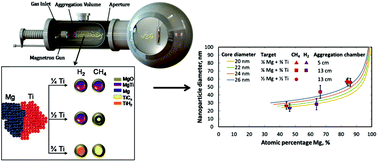Our official English website, www.x-mol.net, welcomes your feedback! (Note: you will need to create a separate account there.)
Shape and structural motifs control of MgTi bimetallic nanoparticles using hydrogen and methane as trace impurities†
Nanoscale ( IF 6.7 ) Pub Date : 2017-12-18 00:00:00 , DOI: 10.1039/c7nr06771b Gopi Krishnan 1, 2, 3, 4, 5 , Sytze de Graaf 1, 2, 3, 4 , Gert H. ten Brink 1, 2, 3, 4 , Marcel A. Verheijen 4, 6, 7, 8 , Bart J. Kooi 1, 2, 3, 4 , George Palasantzas 1, 2, 3, 4
Nanoscale ( IF 6.7 ) Pub Date : 2017-12-18 00:00:00 , DOI: 10.1039/c7nr06771b Gopi Krishnan 1, 2, 3, 4, 5 , Sytze de Graaf 1, 2, 3, 4 , Gert H. ten Brink 1, 2, 3, 4 , Marcel A. Verheijen 4, 6, 7, 8 , Bart J. Kooi 1, 2, 3, 4 , George Palasantzas 1, 2, 3, 4
Affiliation

|
In this work we report the influence of methane/hydrogen on the nucleation and formation of MgTi bimetallic nanoparticles (NPs) prepared by gas phase synthesis. We show that a diverse variety of structural motifs can be obtained from MgTi alloy, TiCx/Mg/MgO, TiCx/MgO and TiHx/MgO core/shell NPs via synthesis using CH4/H2 as a trace gas, and with good control of the final NP morphology and size distribution. Moreover, depending on the concentration of Ti and type of employed trace gas, the as prepared MgTi NPs can be tuned from truncated hexagonal pyramid to triangular and hexagonal platelet shapes. The shape of MgTi NPs is identified using detailed analysis from selected area electron diffraction (SAED) patterns and tomography (3D reconstruction based on a tilt series of Bright-Field transmission electron microscopy (TEM) micrographs). We observe the truncated hexagonal pyramid as a shape of MgTi alloy NPs in contrast to Mg NPs that show a hexagonal prismatic shape. Moreover, based on our experimental observations and generic geometrical model analysis, we also prove that the formation of the various structural motifs is based on a sequential growth mechanism instead of phase separation. One of the prime reasons for such mechanism is based on the inadequacy of Mg to nucleate without template in the synthesis condition. In addition, the shape of the TiCx/TiHx core, and the concentration of Mg have strong influence on the shape evolution of TiCx/MgO and TiHx/MgO NPs compared to TiCx/Mg/MgO NPs, where the thermodynamics and growth rates of the Mg crystal planes dominate the final shape. Finally, it is demonstrated that the core shape of TiCx and TiHx is affected by the Mg/Ti target ratio (affecting the composition in the plasma), and the type of the trace gas employed. In the case of CH4 the TiCx core forms a triangular platelet, while in the case of H2 the TiHx core transforms into a hexagonal platelet. We elucidate the reason for the TiCx/TiHx core shape based on the presence of (i) defects, and (ii) hydrogen and carbon adsorption on {111} planes that alter the growth rates and surface facet stabilization.
中文翻译:

使用氢和甲烷作为痕量杂质控制MgTi双金属纳米颗粒的形状和结构图案†
在这项工作中,我们报告了甲烷/氢对通过气相合成制备的MgTi双金属纳米颗粒(NPs)的形核和形成的影响。我们表明,可以通过使用CH 4 / H 2合成从MgTi合金,TiC x / Mg / MgO,TiC x / MgO和TiH x / MgO核/壳NPs中获得多种结构基序。作为痕量气体,并能很好地控制最终NP的形态和尺寸分布。此外,根据Ti的浓度和所用痕量气体的类型,可以将制备的MgTi NPs从截断的六棱锥调整为三角形和六边形的血小板形状。MgTi NP的形状可通过对选定区域的电子衍射(SAED)模式和层析成像(基于倾斜的明场透射电子显微镜(TEM)显微照片进行3D重建)进行详细分析来识别。我们观察到截断的六棱锥是MgTi合金NP的形状,而Mg NP却显示出六棱柱的形状。此外,根据我们的实验观察和通用的几何模型分析,我们还证明了各种结构基序的形成是基于顺序生长机制而不是相分离。这种机理的主要原因之一是基于在合成条件下镁在没有模板的情况下不能成核。此外,TiC的形状X / TIH X核心,和Mg的浓度对的TiC的形状进化强烈影响X / MgO和TIH X / MgO比的NP相比的TiC X /镁/ MgO比的NP,其中所述Mg晶面的热力学和生长率最终形状占主导地位。最后,证明了TiC x和TiH x的核心形状受Mg / Ti靶比(影响等离子体中的组成)和所用痕量气体类型的影响。在CH 4的情况下,TiC x核形成一个三角形薄片,而在H 2的情况下,TiH x核转化为六角形血小板。我们基于(i)缺陷以及(ii)在{111}面上的氢和碳吸附会改变生长速率和表面刻面稳定性,阐明TiC x / TiH x核形状的原因。
更新日期:2017-12-18
中文翻译:

使用氢和甲烷作为痕量杂质控制MgTi双金属纳米颗粒的形状和结构图案†
在这项工作中,我们报告了甲烷/氢对通过气相合成制备的MgTi双金属纳米颗粒(NPs)的形核和形成的影响。我们表明,可以通过使用CH 4 / H 2合成从MgTi合金,TiC x / Mg / MgO,TiC x / MgO和TiH x / MgO核/壳NPs中获得多种结构基序。作为痕量气体,并能很好地控制最终NP的形态和尺寸分布。此外,根据Ti的浓度和所用痕量气体的类型,可以将制备的MgTi NPs从截断的六棱锥调整为三角形和六边形的血小板形状。MgTi NP的形状可通过对选定区域的电子衍射(SAED)模式和层析成像(基于倾斜的明场透射电子显微镜(TEM)显微照片进行3D重建)进行详细分析来识别。我们观察到截断的六棱锥是MgTi合金NP的形状,而Mg NP却显示出六棱柱的形状。此外,根据我们的实验观察和通用的几何模型分析,我们还证明了各种结构基序的形成是基于顺序生长机制而不是相分离。这种机理的主要原因之一是基于在合成条件下镁在没有模板的情况下不能成核。此外,TiC的形状X / TIH X核心,和Mg的浓度对的TiC的形状进化强烈影响X / MgO和TIH X / MgO比的NP相比的TiC X /镁/ MgO比的NP,其中所述Mg晶面的热力学和生长率最终形状占主导地位。最后,证明了TiC x和TiH x的核心形状受Mg / Ti靶比(影响等离子体中的组成)和所用痕量气体类型的影响。在CH 4的情况下,TiC x核形成一个三角形薄片,而在H 2的情况下,TiH x核转化为六角形血小板。我们基于(i)缺陷以及(ii)在{111}面上的氢和碳吸附会改变生长速率和表面刻面稳定性,阐明TiC x / TiH x核形状的原因。


























 京公网安备 11010802027423号
京公网安备 11010802027423号